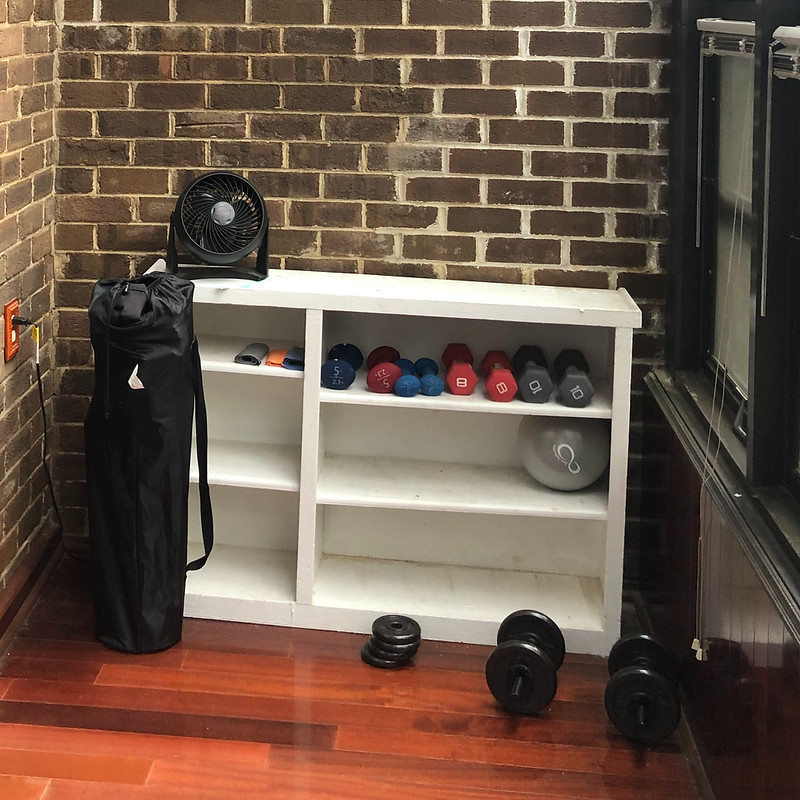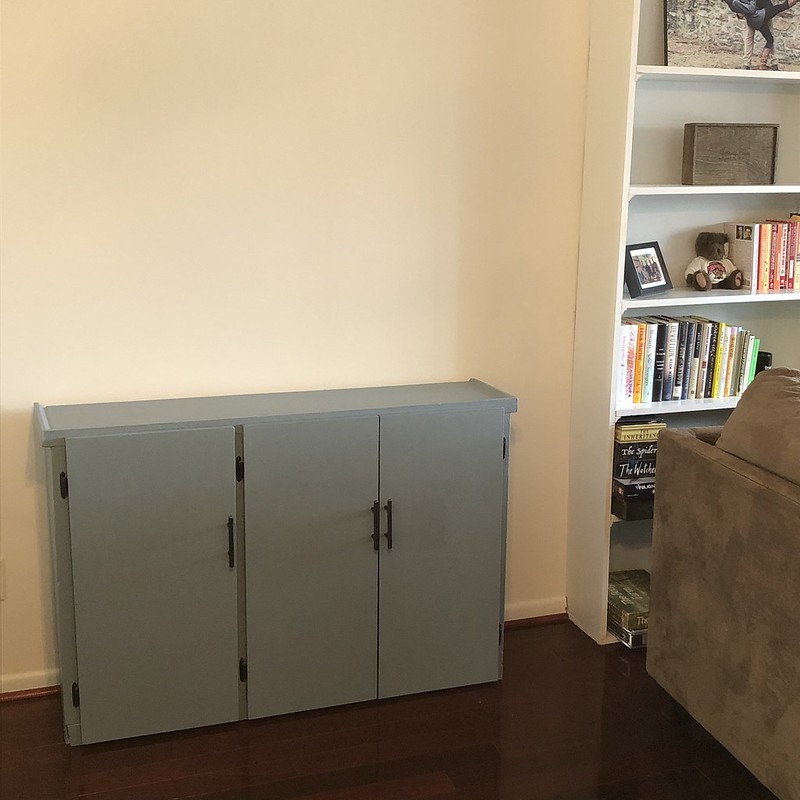Turning a Junky Bookshelf or Entertainment Stand into Useful Sideboard
We've tackled lots of different DIY projects since we've moved into our house. But this junky bookshelf to fancy sideboard transformation might be our most successful project yet.
When we moved into our house, we discovered the previous owners had left a piece of big, white furniture. We didn't quite know what it was. I took to calling it a bookshelf. My husband thought it was possibly some sort of cabinet or entertainment stand.
It was incredibly sturdy, but it was ugly as all get out.
We didn't really know what to do it with it, so it became our de-facto place to store our dumbbells because the shelves were solid wood and didn't bow under their weight. It used to live in our sunroom.
When we converted that to an open air, outdoor space, it moved into our living area.
That's when I really started to hate it and wanted it out of our house. It was so ugly. The paint was chipping in some parts. In other parts, the paint was thick and had dried all gloopy. It was not a nice piece of furniture to have in our house.
The problem was, I couldn't find anything to replace it with. I spent months shopping around for some sort of storage item that would be able to handle all the weight I needed it to, fit in the space and not cost approximately one million dollars.
Then my husband had the brilliant idea to refinish the bookshelf, build doors for it and transform it into a sideboard that could store our workout equipment and keep it out of sight.
And so off we went to the hardware stores. That weekend we hit Ace twice and Home Depot once.
Supplies to refinish the cabinet:
- Sander
- Primer
- Paint (we used Benjamin Moore Amsterdam)
- Sealer specifically for painted wood
Supplies to make the doors:
- One 3/4" x 4' x8' Melamine panel cut down into the size of the three doors (have your measurements handy at Home Depot and they will do this cutting for you)
- Wood filler
- Putty knife
- 3 packs of hinges
- 3 handles
- Drill
When we got all the supplies home, we deconstructed the cabinet, pulling out all the shelves so we could see what we were working with.
Then we started working on the doors. Since we were using a melamine panel, the front and back were nice smooth surfaces. The sides and edges needed some serious sanding. After roughing everything up so the primer would stick, we also sealed the edges with wood filler to make them less rough.
This step took a long time. It required multiple coats of wood filler with lots of sanding in between coats. If no one is going to see the edges of your panels, you can likely skip this and jump straight into priming. But since I'm a bit of a perfectionist, I wanted to make sure the edges of our doors looked top notch.
While I worked on priming the doors, my husband moved on to sanding the shelves and the base of the cabinet.
Priming was slow going because you could only do one side at a time and needed to ensure everything was nice and dry before flipping the doors to work on the other side.
But it was nothing like the pain in the neck my husband was dealing with while sanding. The previous paint job on the bookshelf was terrible. In hindsight, we probably should have just used a paint stripper and started from scratch, but nope, instead my husband just sanded the heck out of it. There was dust everywhere. But the end result was pretty good. The globs of paint were gone, and we had a nice smooth surface to work with.
We gave the base and the shelves all two good coats of primer.
We followed that up with two coats of the paint.
And then lastly, we gave everything three coats of the sealant. I can't stress enough how important it was to seal all the paint. I could see from before how our dumbbells would rip the old paint off the shelves or how easily the previous white paint got chipped. I did not want that happening to the new sideboard after we put all this work into it.
So even though the three coats of sealant took a long time because of the drying time, it was 100 percent worth it.
Then came assembly.
We put the shelves back into place.
We measured where we wanted our doors to hang and then drilled holes to attach the hinges. We worked left to right, starting the with single door, and then working toward the adjoining doors. Hanging doors requires patience. Lots of measuring, lots of leveling to get things just right.
Last but not least, we needed to attach the handles.
We started with the single door again because it was the easiest. Then we moved on to the adjoining doors. This handle installation was a little bit painful. Trying to get everything to perfectly align top to bottom, left to right, when the base of the cabinet wasn't perfectly square was a challenge. But we eventually got it done.
And I'm completely obsessed with how this turned out.
I cannot believe this was the same piece of furniture. A fresh coat of paint and adding some nice doors made a world of difference.
Such a transformation from my most hated piece of furniture to my most favorite.




















0 comments